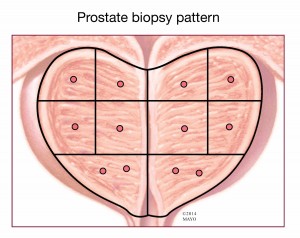-
Weekend Wellness: Gleason score indicates grade of prostate cancer
DEAR MAYO CLINIC: I am 73 and just had a prostate biopsy that showed a malignant tumor with a Gleason score of 8. Is this an indication of an aggressive cancer and if so, what are my treatment options?
ANSWER: Gleason score indicates the grade of your prostate cancer. The higher the Gleason score, the more aggressive the cancer is likely to be.  Of the factors related to prostate cancer that doctors take into consideration when deciding on treatment, Gleason score is probably the most important one. In most cases, treatment with radiation and hormonal therapy or with surgery is recommended based on a Gleason score of 8.
Of the factors related to prostate cancer that doctors take into consideration when deciding on treatment, Gleason score is probably the most important one. In most cases, treatment with radiation and hormonal therapy or with surgery is recommended based on a Gleason score of 8.
The Gleason score was developed in the 1960s by a pathologist named Donald Gleason. It has stood the test of time, and doctors now rely on it to predict how likely prostate cancer is to grow and spread.
For most kinds of cancer, tumor grade is determined by looking at individual cancer cells through a microscope using a high level of magnification to examine the details of those cells. Gleason score is different. With this method, a pathologist examines prostate tissue samples under a microscope using low magnification to observe the patterns of the cancer cells.
Each pattern is given a number, usually 3, 4, or 5. Because many prostate cancers contain more than one pattern, the two most common patterns are added together to make the Gleason score. If the patterns are very similar or if only one pattern is found, then the cancer is given two of the same number.
For example, your Gleason score of 8 likely came from two very similar patterns of 4 and 4. In some cases, a score of 8 may come from a pattern of 5 and 3 or 3 and 5, but those are not common. The first number identifies the primary pattern, or the one seen most predominately in the sample. The second number is the secondary pattern, or one that is visible but not as widespread as the primary pattern.
A prostate cancer biopsy also differs from other forms of cancer in the number of samples a pathologist examines. Rather than just one or two tissue samples, 12 samples are usually taken for a prostate biopsy. Of those samples, some may have different Gleason scores. If that’s the case, the pathologist assigns the highest score observed.
It is worth noting, however, that if only one or two of the samples have a score of 8 and the others are lower, or if some do not show evidence of cancer at all, then the outlook is better than if nine or ten samples are at 8. Your doctor will take that into account when evaluating the outlook for your cancer.
He or she also will review the amount or percentage of cancer found in each sample. If the percentage is low, the overall outlook is better than if the percentage of cancerous tissue is high in the samples.
Generally, with a Gleason score of 8 or higher, treatment is recommended, as long as you do not have other medical problems that would make it hard for you to have radiation and hormonal therapy or surgery. Depending on age and the specific numbers that make up the Gleason score, men who have scores of 6 or 7 may not need immediate treatment. Instead, their doctors may suggest a program of active surveillance to monitor the cancer and to see if it progresses.
Before treatment begins in patients who have higher Gleason scores, most doctors suggest imaging exams such as bone and CT scans or MRI studies of the pelvis and abdomen. This allows your doctor to see if the cancer has spread beyond the prostate and will help your doctor recommend which treatment options are best for you. — R. Jeffrey Karnes, M.D., Urology, Mayo Clinic, Rochester, Minn.







